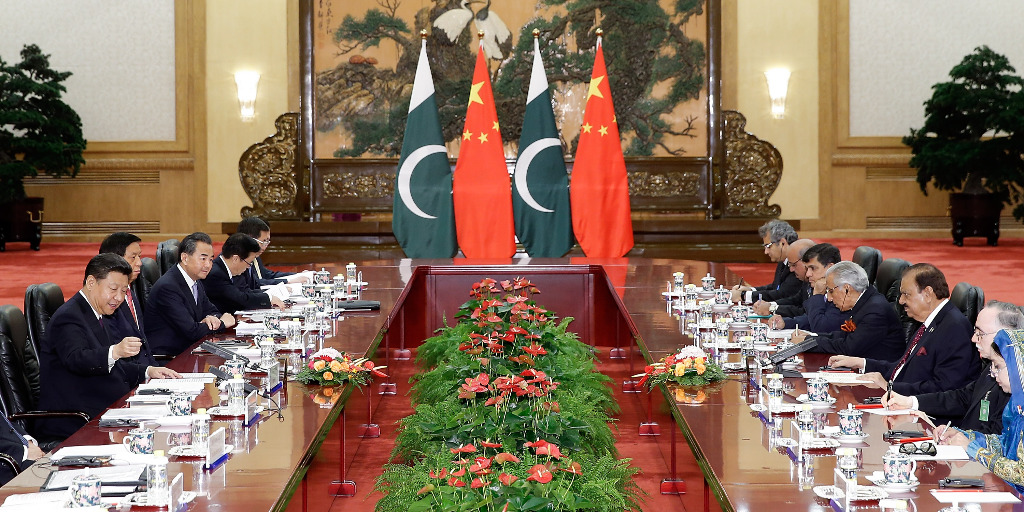
Bottom Line: China’s “One Belt, One Road” economic strategy, aimed at developing regional trades routes connecting East Asia, South Asia, Central Asia and Europe, has expanded into Pakistan where Chinese companies have launched numerous projects to build up Pakistan’s infrastructure and energy sector as part of the China-Pakistan Economic Corridor (CPEC). Through such cooperation, Pakistan has gravitated closer to China’s orbit, generating concerns over Pakistan’s increasing dependence on China and Beijing’s rising global power status.
Background: CPEC is a 15-year economic initiative spanning from 2015-2030, which focuses on expanding Pakistan’s energy sector, enhancing Pakistan’s infrastructure and establishing a direct land route connecting China’s northwestern region of Xianjing to Pakistan’s southern Gwadar Port on the Arabian Sea.
- The groundwork for CPEC was laid in July 2013 when representatives from Pakistan and China signed a memorandum of understanding during former Pakistani Prime Minister Nawaz Sharif’s trip to Beijing. CPEC officially commenced in April 2015 when Chinese President Xi Jinping traveled to Pakistan to oversee the signing of $46 billion in agreements, which included ventures to develop country’s southern Gwadar Port on the Arabian sea, advance Pakistan’s infrastructure and energy sector and increase industrial cooperation between the two nations and throughout the region. Of the initial sum, $35 billion was directed towards boosting the energy sector. The total ballooned to $62 billion in April 2017 when China infused additional funds into CPEC.
- CPEC has improved Pakistan’s infrastructure through the construction of roads, highways, railways gas pipe lines, and energy projects aimed at reducing power outages across the country. Energy projects include building wind farms, coal-fired and hydropower plants and solar power stations as part of an effort to add 10,400 megawatts of energy to Pakistan’s national grid. CPEC also plays a role in promoting Pakistan’s regional connectivity as new roads serve as bridges between South and Central Asia. One of the most critical elements of CPEC is the construction of Gwadar Port, located in southwest, as well as roads and highways that offer China direct land access to the Arabian sea.
- In May 2015, the Pakistani government formed the Parliamentary Committee on CPEC, a political oversight body charged with monitoring the implementation of CPEC and proposing recommendations to improve the initiative. The committee is comprised of representatives from both houses of parliament – the Senate and the National Assembly of Pakistan.
- Thousands of Chinese nationals have traveled to Pakistan to work on these infrastructure projects, posing a heightened security risk for Pakistani authorities to monitor. Chinese nationals and infrastructure projects in Pakistan face persistent threats from terrorist organizations. In December 2017, the Chinese Embassy in Islamabad released a statement warning “all Chinese organizations and citizens in Pakistan to stay vigilant, safeguard personal security, reduce time spent outside and avoid going to crowded places as much as possible.” Beijing has urged Islamabad to guarantee the security of its citizens, particularly after a Chinese national was gunned down by an unidentified assailant in the southern Pakistani city of Karachi in February 2018.
Senator Mushahid Hussain Sayed, Chairman, Parliamentary Committee on China-Pakistan Economic Corridor
 “Greater South Asia means, as a geo-economic concept, connections between China, Iran, Afghanistan, Myanmar, Kazakhstan, Kyrgyzstan, Tajikistan, Turkmenistan and Uzbekistan – Central Asia – driven by economy, driven by energy and woven together by roads, railways, ports and pipelines. Pakistan is the hub of this new regionalism. Because of CPEC, which is part of China’s broader ‘One Belt, One Road’ initiative, we see these linkages happening and these developments created.”
“Greater South Asia means, as a geo-economic concept, connections between China, Iran, Afghanistan, Myanmar, Kazakhstan, Kyrgyzstan, Tajikistan, Turkmenistan and Uzbekistan – Central Asia – driven by economy, driven by energy and woven together by roads, railways, ports and pipelines. Pakistan is the hub of this new regionalism. Because of CPEC, which is part of China’s broader ‘One Belt, One Road’ initiative, we see these linkages happening and these developments created.”
Ahsan Iqbal, Pakistan’s Federal Minister for Interior, Planning, Development and Reforms
 “We have a long-term vision for CPEC that envisages the completion of CPEC in three phases. The first phase, from 2015-2020, focuses on overcoming the infrastructure bottlenecks in Pakistan, which means fixing the energy crisis, the infrastructure gaps so that Pakistan has a functioning foundation for a modern economy. The next phase is 2020-2025 and that focuses on industrial cooperation. Once the infrastructure is there, the energy and roads are there, and the transportation is there, we will then build industrial partnerships and special economic zones in different provinces that will create activity in Pakistan. The third phase is 2025-2030. That envisages that based on this infrastructure and industry, Pakistan should be able to integrate in the region, specifically in South Asia, Central Asia and China…The idea of CPEC is to create a platform of connectivity where regions can connect because history has proven that those regions that connect prosper faster.”
“We have a long-term vision for CPEC that envisages the completion of CPEC in three phases. The first phase, from 2015-2020, focuses on overcoming the infrastructure bottlenecks in Pakistan, which means fixing the energy crisis, the infrastructure gaps so that Pakistan has a functioning foundation for a modern economy. The next phase is 2020-2025 and that focuses on industrial cooperation. Once the infrastructure is there, the energy and roads are there, and the transportation is there, we will then build industrial partnerships and special economic zones in different provinces that will create activity in Pakistan. The third phase is 2025-2030. That envisages that based on this infrastructure and industry, Pakistan should be able to integrate in the region, specifically in South Asia, Central Asia and China…The idea of CPEC is to create a platform of connectivity where regions can connect because history has proven that those regions that connect prosper faster.”
Dan Markey, Senior Research Professor and Academic Director of the Global Policy Program, the Johns Hopkins School of Advanced International Studies
 “Viewed optimistically, CPEC has the potential to jumpstart Pakistan’s economy, filling in some obvious gaps of foreign direct investment, infrastructure and energy. China’s support also comes at a time when Pakistan was feeling internationally isolated and beleaguered, so it should not be underestimated. On the other hand, there are huge questions about whether the terms and processes of CPEC will ultimately bring sustainable growth and domestic political stability to Pakistan, and whether China’s backing will help Pakistan find a path toward regional normalization or heightened tensions. I have deep concerns on both counts.”
“Viewed optimistically, CPEC has the potential to jumpstart Pakistan’s economy, filling in some obvious gaps of foreign direct investment, infrastructure and energy. China’s support also comes at a time when Pakistan was feeling internationally isolated and beleaguered, so it should not be underestimated. On the other hand, there are huge questions about whether the terms and processes of CPEC will ultimately bring sustainable growth and domestic political stability to Pakistan, and whether China’s backing will help Pakistan find a path toward regional normalization or heightened tensions. I have deep concerns on both counts.”
Issue: China has strategically employed economic tactics to leverage its influence across South, Central and East Asia. Beijing may seize upon its economic opportunism in Pakistan to install a long-term military presence in the country and bring Islamabad closer into its fold, which would alarm U.S. policymakers and present a new set of challenges for an already tumultuous U.S.-Pakistan relationship.
- China is reportedly planning to construct its second overseas naval base at Pakistan’s southern Gwadar Port, although these claims have been denied by Chinese executives in charge of building the port. The construction of a military base at Gwadar would represent another manifestation of China’s rapid military advancement and expansion and poses a growing threat to U.S. interests and allies in South and East Asia.
- The Pakistani military has provided security for Chinese development initiatives in Pakistan, deploying a 15,000 troop force to protect CPEC projects. Such efforts could pave the way for heightened security coordination between the China and Pakistan and possibly expand China’s military presence into new theaters.
- Economic and military cooperation between Pakistan and China could exacerbate tensions in the region, particularly if India – Pakistan’s longtime nemesis – feels encircled by China and Pakistan. If not carefully managed, the situation could devolve into a larger geostrategic realignment with China and Pakistan on one side and the U.S. and India on the other.
Michael Kugelman, Deputy Director of the Asia Program and Senior Associate for South Asia at the Wilson Center
 “So much about CPEC is either shrouded in secrecy or so opaque that it’s impossible to figure out what’s really going on. Both China and Pakistan deny there will be a naval base, but these denials haven’t assuaged the fears of New Delhi or Washington. I wouldn’t be surprised if Beijing seeks to build a base; it will want to be able to better project military power to protect all its new investments in Pakistan and beyond. And I couldn’t imagine Pakistan, its closest friend, opposing such a move. India would be alarmed if China were to build a base off Gwadar, as it would enable its main strategic rival to project power in India’s backyard. Ultimately, this would be a net win for Islamabad, India’s bitter rival.”
“So much about CPEC is either shrouded in secrecy or so opaque that it’s impossible to figure out what’s really going on. Both China and Pakistan deny there will be a naval base, but these denials haven’t assuaged the fears of New Delhi or Washington. I wouldn’t be surprised if Beijing seeks to build a base; it will want to be able to better project military power to protect all its new investments in Pakistan and beyond. And I couldn’t imagine Pakistan, its closest friend, opposing such a move. India would be alarmed if China were to build a base off Gwadar, as it would enable its main strategic rival to project power in India’s backyard. Ultimately, this would be a net win for Islamabad, India’s bitter rival.”
Dan Markey, Senior Research Professor and Academic Director of the Global Policy Program, the Johns Hopkins School of Advanced International Studies
 “For at least a decade, analysts have been thinking more seriously about the potential of ‘bloc’ politics in South Asia, with the United States and India on the one side, China and Pakistan on the other. The analogy to the Cold War era is striking, when the U.S.-USSR global competition led Washington and Moscow to take sides in South Asia. But this time the teams are different. CPEC can be interpreted as a tightening of China-Pakistan relations, just as the civil nuclear deal with India brought Washington and New Delhi closer. Play that dynamic and you do have reasons to anticipate a further unraveling of U.S.-Pakistan ties.”
“For at least a decade, analysts have been thinking more seriously about the potential of ‘bloc’ politics in South Asia, with the United States and India on the one side, China and Pakistan on the other. The analogy to the Cold War era is striking, when the U.S.-USSR global competition led Washington and Moscow to take sides in South Asia. But this time the teams are different. CPEC can be interpreted as a tightening of China-Pakistan relations, just as the civil nuclear deal with India brought Washington and New Delhi closer. Play that dynamic and you do have reasons to anticipate a further unraveling of U.S.-Pakistan ties.”
Senator Mushahid Hussain Sayed, Chairman, Parliamentary Committee on China-Pakistan Economic Corridor
 “The U.S. has become more tactical while China is more strategic. We can bank on China, we can rely on China. There is none of this Congress being unhappy, the CIA being unhappy, the military being unhappy or them cutting off aid.”
“The U.S. has become more tactical while China is more strategic. We can bank on China, we can rely on China. There is none of this Congress being unhappy, the CIA being unhappy, the military being unhappy or them cutting off aid.”
Response: The U.S. has responded to China’s expansionism by enhancing its partnership with strategic allies in the region such as Australia, Japan and India, in what has become known as the “Quad,” and by voicing its opposition to China’s chartered course of dictating regional events through economic means. And while CPEC may offer new investment opportunities for U.S. companies inside Pakistan, it may also circuitously bolster U.S.-India ties as both nations look to offset a rising China-Pakistan alliance.
- Last October, during a hearing before the Senate Armed Services Committee, U.S. Secretary of Defense Jim Mattis voiced opposition to CPEC stating that, “In a globalized world, there are many belts and many roads, and no one nation should put itself into a position of dictating ‘One belt, One road.’’’ Further, Mattis asserted that, “The One Belt One Road also goes through disputed territory {in Kashmir between Pakistan and India} and I think that in itself shows the vulnerability of trying to establish that sort of a dictate.”
- Heads of state from the U.S., Australia, India and Japan – the Quad – all met in the Philippines last November to assess areas where closer cooperation could be undertaken as well as to weigh potential responses to China’s aggression in the South China Sea and throughout Asia. The countries may also be planning their own joint infrastructure endeavor as a counter to China’s “One Belt, One Road.”
- At the same time, CPEC may offer additional investment opportunities for U.S. companies in Pakistan. In January, representatives from the U.S.-based World Technological & Trade, Inc. (WTTI) visited Pakistan’s Intellectual Property Organization to discuss potential investment opportunities in the mining, information technology, robotics and pharmaceuticals sectors.
- As China has strengthened its ties to Pakistan through CPEC, the Trump administration has also lauded bilateral relations with India. Last week, U.S. President Donald Trump signed a National Security Presidential Memorandum approving a new Conventional Arms Transfer (CAT) policy, which eases restrictions on arms sales, including unmanned aerial vehicles, to U.S. allies. Indian media outlets report that such a policy change may facilitate the transfer of U.S. armed drones to India, which has sought to purchase 400 drones and advanced weapons from the U.S. as a means of upgrading its military capabilities.
Tanvi Madan, director of The India Project, Brookings Institution
 “CPEC per se hasn’t been a driver of the Quad, but the four countries have, in part, a shared concern about Chinese actions and rising influence in the region, including via the Belt and Road Initiative more broadly. There are concerns about the terms of the deals that Beijing is signing with various countries, including in the Indian Ocean region, that might be exacerbating existing problems in these countries (such as debt burdens). The Quad countries are also concerned—to different degrees—about the political and strategic leverage that China is gaining via these economic ties. These concerns and regional connectivity more broadly were on the agenda at the quad meeting last fall. Whether in the quadrilateral, trilaterally, bilateral, or unilateral format, the countries have been trying to generate and provide alternatives, as a senior U.S. diplomat put it ‘high-standard projects that make economic sense, that genuinely benefit the recipient countries, and that can attract private capital.’”
“CPEC per se hasn’t been a driver of the Quad, but the four countries have, in part, a shared concern about Chinese actions and rising influence in the region, including via the Belt and Road Initiative more broadly. There are concerns about the terms of the deals that Beijing is signing with various countries, including in the Indian Ocean region, that might be exacerbating existing problems in these countries (such as debt burdens). The Quad countries are also concerned—to different degrees—about the political and strategic leverage that China is gaining via these economic ties. These concerns and regional connectivity more broadly were on the agenda at the quad meeting last fall. Whether in the quadrilateral, trilaterally, bilateral, or unilateral format, the countries have been trying to generate and provide alternatives, as a senior U.S. diplomat put it ‘high-standard projects that make economic sense, that genuinely benefit the recipient countries, and that can attract private capital.’”
Michael Kugelman, Deputy Director of the Asia Program and Senior Associate for South Asia at the Wilson Center
 “The degree of interest from U.S. companies depends on how corporate America perceives the various challenges and obstacles associated with CPEC. There’s also the question as to how much of an appetite American investors have for financing a project that has been dominated by Chinese capital. Even in the years before CPEC, foreign investors were expressing concern that China’s deep levels of investment in Pakistan meant that there was not a level playing field for others wanting to get involved. All this said, Pakistan and China have sought to cast CPEC as an inclusive enterprise and welcome the contributions of others. If Islamabad makes an effective pitch, and if American companies overcome their reservations, then I think there’s some potential. The fact that several U.S. companies, including General Electric, have already invested in CPEC could be a spark for more involvement as well.”
“The degree of interest from U.S. companies depends on how corporate America perceives the various challenges and obstacles associated with CPEC. There’s also the question as to how much of an appetite American investors have for financing a project that has been dominated by Chinese capital. Even in the years before CPEC, foreign investors were expressing concern that China’s deep levels of investment in Pakistan meant that there was not a level playing field for others wanting to get involved. All this said, Pakistan and China have sought to cast CPEC as an inclusive enterprise and welcome the contributions of others. If Islamabad makes an effective pitch, and if American companies overcome their reservations, then I think there’s some potential. The fact that several U.S. companies, including General Electric, have already invested in CPEC could be a spark for more involvement as well.”
Looking Ahead: The ambitious “China Dream” of national rejuvenation introduced by China’s President Xi Jinping in March 2013 clearly articulates China’s goals of establishing a powerful and prosperous China by 2020 and emerging as a military power commensurate with the status of a great power by 2050. Through CEPC and other ventures within its “One Belt, One Road” initiative, China seems poised to further expand its influence across the eastern hemisphere while appealing to countries, including Pakistan, that will reap the benefits of Chinese adventurism, and may challenge U.S. economic influence in the region.
Senator Mushahid Hussain Sayed, Chairman, Parliamentary Committee on China-Pakistan Economic Corridor
 “The world has changed, and the region has changed. The U.S. used to be the sole superpower, but that is no longer. The U.S. is not that powerful, the U.S. is not that strong. And we see a general decline of the West. The East is rising, and the West is in decline. In the east, China is the rising power. And the U.S. is not able to figure all of this out.”
“The world has changed, and the region has changed. The U.S. used to be the sole superpower, but that is no longer. The U.S. is not that powerful, the U.S. is not that strong. And we see a general decline of the West. The East is rising, and the West is in decline. In the east, China is the rising power. And the U.S. is not able to figure all of this out.”
Bennett Seftel is director of analysis at The Cipher Brief. Follow him on Twitter @BennettSeftel.
